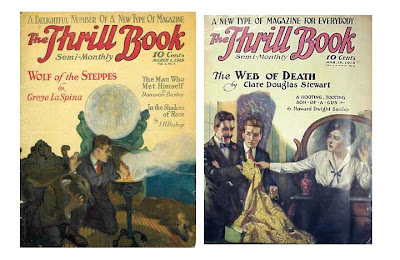In my previous article, I wrote about the American magazine Strange Tales of Mystery and Terror. Today I will write about the similarly titled British magazine Strange Tales of the Mysterious and Supernatural. Like its predecessor, the British Strange Tales was shortlived, lasting only two issues.
I don't know what connection the American magazine Weird Tales might have had to a British magazine of weird fiction and fantasy, but Weird Tales would not have been unfamiliar to British readers. The American version of the magazine would easily have made the crossing to Great Britain by mail. Over the years, many British writers contributed to Weird Tales. More to the point, Weird Tales was printed in a British edition on three occasions, once prior to the publication of Strange Tales, once roughly contemporary with it, and once afterwards:
- Weird Tales war edition--G.G. Swan of London printed three issues of Weird Tales, one each in February, March, and June of 1942. The first American servicemen arrived in the British Isles at about that time. The British wartime edition may have been printed for their reading pleasure, but I don't know that anyone has addressed that as a possibility. (Those three issues were reprints of the September 1940, November 1940, and January 1941 issues of Weird Tales, respectively.)
- Weird Tales ca. 1946 edition--William C. Merrett of London printed one unnumbered, undated issue in about 1946. That issue reprinted selections from the October 1937 issue of Weird Tales.
- Weird Tales 1953-1954 edition--Thorpe & Porter of Leicester printed twenty-eight issues of Weird Tales with roughly the same contents of selected American issues from July 1949 to May 1954.
In addition, British readers would have seen Christine Campbell Thomson's Not At Night series. Printed in a dozen volumes between 1925 and 1937, the stories from the Not At Night series numbered 170 in all. One hundred of those stories came from Weird Tales. (1) The upshot of all this is that Weird Tales and a taste for weird fiction had, by 1946, made the crossing to the United Kingdom.
As I said, Strange Tales of the Mysterious and Supernatural lasted all of two issues dated six months apart. That suggests either a semi-annual schedule or real trouble. We should remember that Britain underwent a period of severe austerity after the war ended. (2) The British Strange Tales would have suffered from economic hard times just as its American predecessor had. In any case, the publisher was--ironically--Utopian Publications of London. The editor is unknown.
Here is the complete list of contents from the first published issue, called the "First Selection", provided by Susanne V. Paradis:
- "Non-Stop to Mars" by Jack Williamson (originally as "Nonstop to Mars" in Argosy, Feb. 25, 1939)
- "Pink Elephants" by Tarleton Fiske (originally in Strange Stories, Aug. 1939, as by Robert Bloch)
- "The Brain of Ali Khan" by Lloyd Arthur Eshbach (originally in Wonder Stories, Oct. 1934)
- "The Hunters from Beyond" by Clark Ashton Smith (originally in Strange Tales of Mystery and Terror, Oct. 1932)
- "Experiment in Murder" by John Russell Fearn (originally as "Portrait of a Murderer" in Weird Tales, Dec. 1936)
- "The Tombstone" by Ray Bradbury (originally in Weird Tales, Mar. 1945)
- Cover art by Alva Rogers; interior illustrations by Fredric
Here are the contents of the second published issue, called the "Second Selection." I believe this to be a complete list:
- "The Moon Devils" by John Beynon Harris, pseudonym of John Wyndham (originally in Wonder Stories, Apr. 1934)
- "The Nameless Offspring" by Clark Ashton Smith (originally in the American Strange Tales, June 1932)
- "The Sorcerer's Jewel" by Tarleton Fiske, pseudonym of Robert Bloch (originally in Strange Stories, Feb. 1939)
- "The Song of the Dark Star" by Richard Presley Tooker (originally as "The Song from the Dark Star" in Astounding Stories, Sept. 1936)
- "Cool Air" by H.P. Lovecraft (originally in Tales of Magic and Mystery, Mar. 1928; reprinted in Weird Tales, Sept. 1939)
- "The Manikin" by Robert Bloch (originally as "The Mannikin" in Weird Tales, Apr. 1937)
- Cover art by Alva Rogers; interior illustrations by Fredric
According to a vague listing on an Internet book sale site, the First Selection was actually the second issue. The first issue was withdrawn either from publication or from distribution because the cover art showed a woman with bare breasts. The website doesn't say what happened to that first issue or what its contents might have been. I wonder if the First Selection was just a reprinting of the first issue with a different cover. In any case, with the Second Selection, the whole magazine went the way of the first issue. Luckily for us, Thomas G. Cockcroft indexed the contents of the magazine in the 1960s.
Strange Tales of the Mysterious and Supernatural
Apr. 1946 to Oct. 1946
2 Issues
Published by: Utopian Publications, London, England
Edited by: Unknown
Format: A little less than digest size (4-3/4 x 7-1/4 inches); 64 pages
Notes
(1) Christine Campbell Thomson also contributed to Weird Tales under the pen name Flavia Richardson in 1927 and 1929.
(2) George Orwell composed 1984 during this period (1947-1948). I have read that apologists for totalitarianism (they don't call themselves that, but that is their function) consider Orwell's novel to be merely a satire of postwar British austerity. The rest of us know better.
 |
| As a bonus, here's an interior illustration by an artist named Fredric for "Cool Air" by H.P. Lovecraft, reprinted in Strange Tales in October 1946. |
 |
| Postscript (July 8, 2015): Here is a much better image of Strange Tales number one, kindly provided by Susanne V. Paradis, who has a copy of the magazine offered for bid on Ebay. Thank you, Susanne. You can find her listing by clicking here. |
Revised and updated on July 8, 2015.
Text and captions copyright 2013, 2023 Terence E. Hanley




























